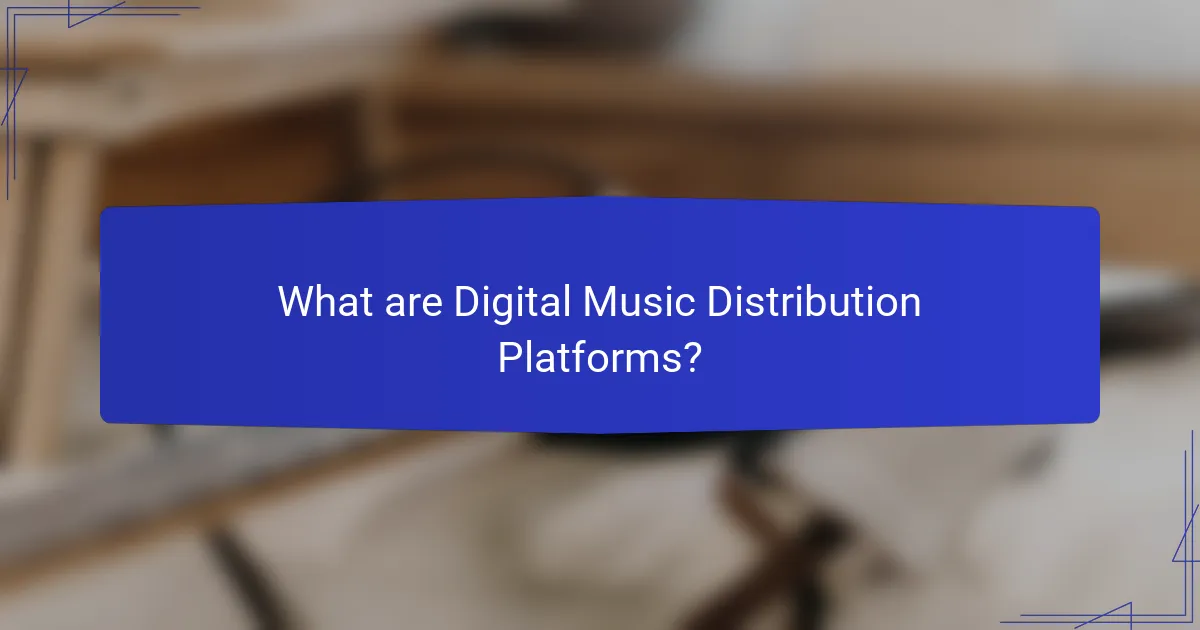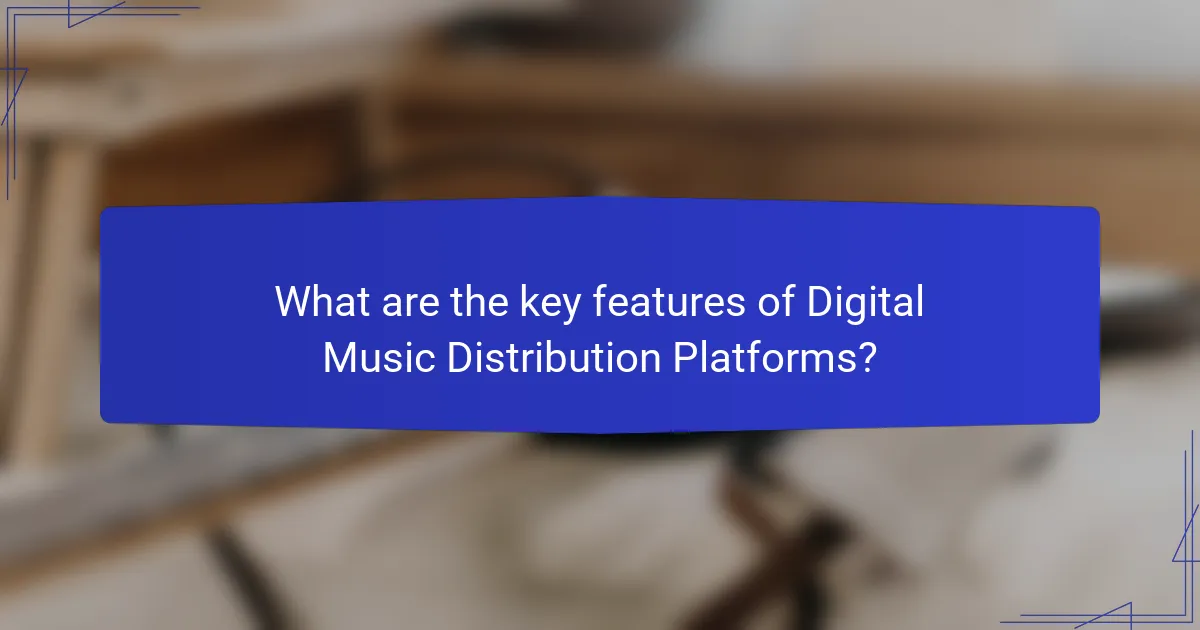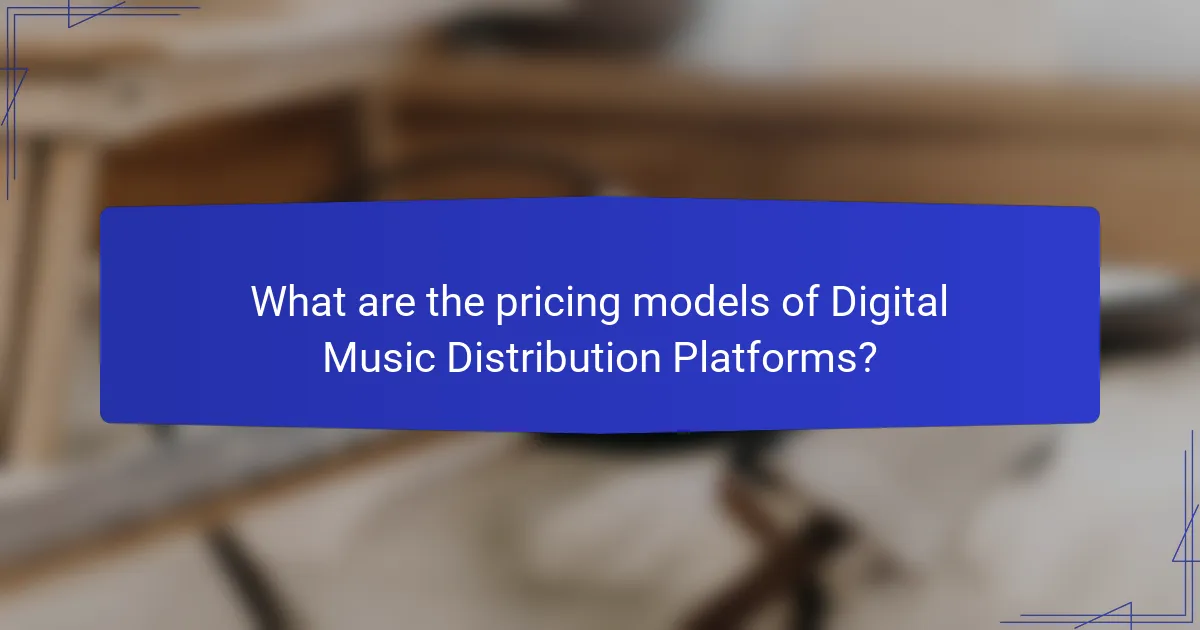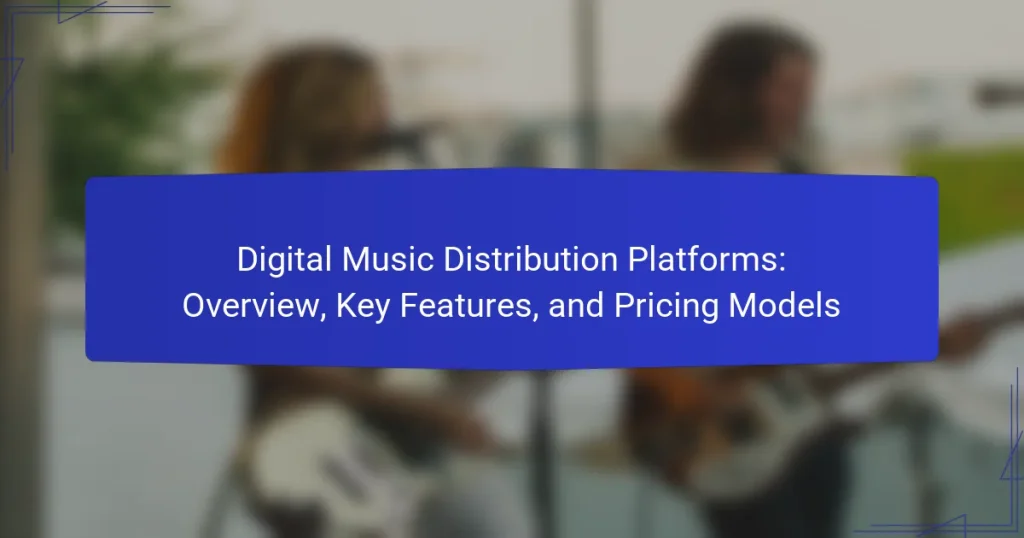Digital music distribution platforms are services that facilitate the distribution of music from artists to digital stores and streaming services, acting as intermediaries with major retailers. This article provides an overview of these platforms, highlighting their key features, such as wide distribution networks, analytics tools, royalty collection, and promotional resources. It also examines the global digital music distribution market, valued at approximately $10 billion in 2020, and outlines the three primary pricing models: subscription-based, pay-per-release, and commission-based. Each model caters to different artist needs and strategies, making it essential for musicians to choose the right platform for effective music distribution.

What are Digital Music Distribution Platforms?
Digital music distribution platforms are services that enable artists to distribute their music to digital stores and streaming services. These platforms act as intermediaries between artists and major digital music retailers. They facilitate the uploading, distribution, and monetization of music. Common examples include DistroKid, TuneCore, and CD Baby. These services often provide additional features like analytics, royalty collection, and marketing tools. The global digital music distribution market was valued at approximately $10 billion in 2020, highlighting its significance in the music industry.
How do Digital Music Distribution Platforms operate?
Digital music distribution platforms operate by providing artists and labels a means to distribute their music to various online stores and streaming services. They serve as intermediaries between music creators and digital retailers. Artists upload their music to the platform, which then processes the files and metadata. The platform ensures that the music meets the technical requirements of each retailer. Once approved, the platform distributes the music to multiple outlets simultaneously. This increases visibility and accessibility for the artists. Additionally, these platforms often handle royalty collection and reporting. They may charge fees or take a percentage of sales as compensation. This operational model streamlines the distribution process for artists, allowing them to focus on creating music.
What are the key processes involved in music distribution?
The key processes involved in music distribution include content delivery, licensing, and royalty collection. Content delivery involves uploading music to digital platforms. This process ensures that songs are available for streaming or purchase. Licensing secures the rights needed to distribute the music legally. This is crucial for compliance with copyright laws. Royalty collection tracks and manages earnings from music sales and streams. This process ensures that artists and rights holders receive their due payments. Each of these processes is essential for effective music distribution in the digital landscape.
How do platforms manage licensing and copyright issues?
Platforms manage licensing and copyright issues by establishing agreements with rights holders. They typically negotiate licensing agreements to secure the legal right to distribute music. These agreements define the scope of usage, including duration and geographical limits. Platforms also implement digital rights management (DRM) technologies to protect copyrighted content. They monitor usage to ensure compliance with licensing terms. Furthermore, platforms may use automated systems to identify and manage copyrighted material. This helps in tracking royalties and ensuring that creators are compensated. Compliance with copyright laws is crucial for platforms to avoid legal disputes.
Why are Digital Music Distribution Platforms important for artists?
Digital music distribution platforms are crucial for artists because they enable widespread access to music. These platforms allow artists to reach global audiences through major streaming services. They simplify the process of getting music onto platforms like Spotify and Apple Music. Artists can manage their releases and royalties effectively through these services. Many platforms provide analytics to track listener engagement and sales. This data helps artists make informed decisions about marketing and future releases. Additionally, digital distribution reduces the costs associated with physical media production. The global music market generated over $23 billion in revenue in 2020, highlighting the importance of digital distribution for artists.
What advantages do these platforms provide for independent musicians?
Digital music distribution platforms offer several advantages for independent musicians. They provide access to a global audience through major streaming services. This exposure can significantly increase a musician’s fan base. Additionally, these platforms often allow for higher revenue shares compared to traditional record labels. Independent artists can retain more control over their music and branding. Many platforms also offer user-friendly tools for marketing and promotion. This includes analytics to track listener engagement and sales. Furthermore, musicians can release music on their own schedules without the constraints of a label. These factors contribute to a more sustainable career for independent artists.
How do they enhance visibility and reach for artists?
Digital music distribution platforms enhance visibility and reach for artists by providing access to major streaming services. They distribute music to platforms like Spotify, Apple Music, and Amazon Music. This broadens the audience base significantly. Artists can reach millions of potential listeners globally. Additionally, these platforms offer promotional tools to boost visibility. Features such as playlist placements and targeted marketing campaigns are available. Analytics provided by these platforms help artists understand their audience better. This data-driven approach allows for more effective marketing strategies.

What are the key features of Digital Music Distribution Platforms?
Digital music distribution platforms enable artists to distribute their music across various online stores and streaming services. Key features include wide distribution networks, allowing access to major platforms like Spotify and Apple Music. They often provide analytics tools to track performance and audience engagement. User-friendly interfaces facilitate easy uploading and management of music. Many platforms offer royalty collection services, ensuring artists receive payment for streams and downloads. Some provide promotional tools to enhance visibility and marketing efforts. Additionally, customer support is commonly available to assist users with technical issues. These features collectively empower artists to reach wider audiences and optimize their music distribution strategy.
What core functionalities should artists look for in these platforms?
Artists should look for user-friendly interfaces in digital music distribution platforms. A straightforward interface simplifies the upload process and makes navigation easier. Comprehensive analytics tools are essential for tracking streams and sales. These tools provide insights into audience engagement and revenue generation. Flexible pricing models allow artists to choose plans that suit their needs. This flexibility can enhance profitability and reduce unnecessary costs.
Additionally, platforms should offer broad distribution networks. A wide reach ensures music is available on multiple streaming services. Effective customer support is another critical functionality. Responsive support can assist artists with issues that may arise during distribution. Lastly, copyright protection features are vital. These features safeguard artists’ intellectual property rights in the digital space.
How do platforms support various music formats and quality?
Digital music distribution platforms support various music formats and quality by offering compatibility with multiple audio file types. Common formats include MP3, WAV, FLAC, and AAC. Each format caters to different user needs, such as file size and audio fidelity. Platforms often allow users to upload and stream music in these formats seamlessly.
Additionally, many platforms provide options for high-resolution audio, enhancing sound quality for audiophiles. Streaming quality settings may vary, enabling users to choose between lower and higher bitrates based on their internet connection. This flexibility ensures a wide range of audio experiences, from casual listening to professional-grade sound.
For instance, platforms like Tidal and Qobuz specifically promote high-resolution audio streaming, supporting lossless formats. This commitment to diverse formats and quality levels allows platforms to cater to a broad audience with varying preferences and technical requirements.
What tools do they offer for marketing and promotion?
Digital music distribution platforms offer several tools for marketing and promotion. These tools include social media integration for easy sharing of music. They provide pre-save campaigns to boost streaming numbers upon release. Email marketing tools help artists connect directly with their fan base. Some platforms offer playlist submission services to increase visibility. Additionally, they may include analytics tools to track performance and engagement. These features collectively enhance an artist’s promotional efforts in a competitive market.
How do different platforms compare in terms of user experience?
Different digital music distribution platforms vary significantly in user experience. Platforms like DistroKid offer a straightforward interface and fast distribution times. In contrast, TuneCore provides detailed analytics but may have a steeper learning curve. CD Baby combines user-friendly navigation with personalized support options. Each platform’s pricing model also impacts user experience; DistroKid charges an annual fee, while TuneCore takes a percentage of sales. User feedback often highlights the importance of customer service in overall satisfaction. Reports indicate that platforms with responsive support receive higher user ratings. Therefore, user experience is influenced by interface design, analytics, support, and pricing structures.
What user interface elements are crucial for ease of use?
Intuitive navigation is crucial for ease of use in user interfaces. Clear menus and logical pathways enable users to find content quickly. Responsive design ensures accessibility across devices, enhancing user experience. Visual hierarchy helps prioritize information, guiding users effectively. Feedback mechanisms, such as notifications or confirmations, keep users informed about their actions. Consistent design elements foster familiarity, reducing the learning curve. Search functionality allows users to locate specific content efficiently. These elements collectively improve usability and user satisfaction in digital music distribution platforms.
How do platforms facilitate artist engagement and feedback?
Platforms facilitate artist engagement and feedback through interactive features and analytics tools. These features include comment sections, direct messaging, and live streaming options. Artists can communicate directly with fans, fostering a sense of community. Analytics tools provide insights into listener demographics and engagement metrics. This data helps artists understand their audience better. Platforms often host Q&A sessions and polls for real-time feedback. These methods encourage active participation from fans. Additionally, social media integration allows for broader outreach and interaction. This engagement ultimately enhances the artist’s connection with their audience.

What are the pricing models of Digital Music Distribution Platforms?
Digital music distribution platforms typically use three main pricing models: subscription-based, pay-per-release, and commission-based. Subscription-based models charge artists a recurring fee for access to distribution services. This fee often covers unlimited releases within the subscription period. Pay-per-release models require artists to pay a fee for each individual release. This model allows for flexibility in distribution but can become costly for frequent releases. Commission-based models take a percentage of the revenue generated from sales or streams. This model aligns the platform’s success with the artist’s success. Each model has its advantages, catering to different artist needs and distribution strategies.
How do platforms typically charge for their services?
Platforms typically charge for their services through subscription fees, commission rates, or one-time fees. Subscription fees are common, where users pay a monthly or annual fee for access to services. For example, digital music distribution platforms may charge a flat rate for unlimited uploads. Commission rates involve taking a percentage of sales generated through the platform, which incentivizes platforms to support artists. Some platforms also offer one-time fees for specific services, like album releases or promotional tools. This pricing structure allows flexibility for users, accommodating various needs and budgets.
What are the differences between subscription and commission-based models?
Subscription models charge users a recurring fee for access to services or content. Users gain unlimited access during the subscription period. This model provides predictable revenue for businesses. Examples include Spotify and Apple Music.
Commission-based models earn revenue by taking a percentage of sales made through the platform. Artists or sellers pay a fee only when a transaction occurs. This model aligns business success with user sales. Examples include Bandcamp and SoundCloud.
The key difference lies in revenue generation. Subscription models rely on consistent user payments. Commission-based models depend on transaction volume. Each model suits different business strategies and user preferences.
How do upfront fees impact artists’ decisions?
Upfront fees significantly influence artists’ decisions regarding digital music distribution. Many artists may hesitate to commit to platforms with high initial costs. This hesitation stems from the financial risk associated with upfront payments. Artists often prioritize platforms that offer lower or no upfront fees. Lower fees allow artists to retain more of their earnings. Additionally, upfront fees can deter emerging artists who have limited budgets. Research shows that 60% of independent musicians prefer platforms with minimal upfront costs. This preference shapes their choice of distribution services.
What factors influence the pricing of these platforms?
The pricing of digital music distribution platforms is influenced by multiple factors. These include the level of service provided, which may vary from basic distribution to comprehensive marketing support. The percentage taken from sales is another significant factor, with some platforms charging a flat fee while others take a commission on revenue. The number of distribution channels offered also impacts pricing; broader access typically incurs higher costs. Additionally, the presence of added features like analytics and promotional tools can increase fees. Market competition plays a role, as platforms adjust pricing to remain attractive to artists. Lastly, the reputation and established user base of a platform can justify higher costs due to perceived value.
How do distribution reach and services offered affect pricing?
Distribution reach and services offered significantly affect pricing in digital music distribution. A broader distribution reach allows platforms to access more markets and audiences. This increased exposure can justify higher pricing due to the potential for greater sales volume. Additionally, platforms offering extensive services, such as marketing support or data analytics, often charge premium rates. These services add value, making higher prices acceptable to artists and labels seeking comprehensive solutions. For example, platforms that provide playlist placements or promotional tools can command higher fees due to the potential for increased visibility and revenue for artists.
What role do additional features play in overall cost?
Additional features significantly increase the overall cost of digital music distribution platforms. These features often include advanced analytics, promotional tools, and enhanced customer support. Each additional feature adds to the base price of the service. For example, platforms may charge extra for features like detailed sales reports or social media integration. According to a survey by Music Business Worldwide, platforms offering premium features can charge up to 30% more than those with basic offerings. This pricing strategy reflects the added value perceived by users seeking comprehensive distribution solutions. Thus, the role of additional features is crucial in determining the final cost of these platforms.
What tips can artists follow when choosing a Digital Music Distribution Platform?
Artists should consider several key factors when choosing a Digital Music Distribution Platform. First, evaluate the platform’s distribution reach. A broader reach ensures more exposure for the artist’s music. Second, examine the pricing structure. Some platforms charge upfront fees, while others take a percentage of earnings. Third, check for additional services. Many platforms offer marketing tools, analytics, and support. Fourth, consider the ease of use. A user-friendly interface can streamline the distribution process. Fifth, look for customer support options. Reliable support can assist with any issues that arise. Lastly, read reviews and testimonials. Feedback from other artists can provide insight into the platform’s reliability and effectiveness.
Digital music distribution platforms are services that facilitate the distribution of music from artists to digital stores and streaming services. This article provides an overview of how these platforms operate, the key processes involved in music distribution, and their importance for artists, particularly independent musicians. It discusses essential features such as licensing management, marketing tools, and user experience, while also comparing various pricing models, including subscription-based and commission-based structures. Additionally, the article outlines factors influencing pricing and offers tips for artists on selecting the most suitable distribution platform for their needs.


